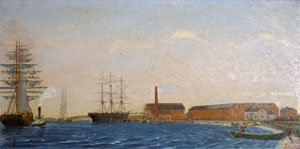Historical Paintings of Woods Hole and Falmouth by F. L. Gifford

The Pacific Guano Company, 1870
This fertilizer plant was located on the property formerly owned by William Robinson (1). The view is westward from the present site of the Woods Hole Yacht Club.
It is difficult to imagine Penzance Point as ever having been given over to heavy industry, but such it was in 1863 when the Pacific Guano Company located its chemical laboratories and processing plant at Woods Hole. It brought welcome employment to the town, but the stench, particularly on west winds, was all but overpowering.
Crude guano (the excrement of sea fowl, rich in the phosphates and nitrogenous matter helpful to plant growth) was shipped to Woods Hole from the distant "guano" islands. At the works in Woods Hole, the guano was combined with oil-free bone scrap from menhaden to produce a superior type of dry fertilizer.
The Pacific Guano Company was the principal industry of the town for 30 years. The company was organized in 1863 by Prince S. Crowell with the help of capital interests in Boston and New York. From 150 to 200 men were regularly employed, many of whom were Irish laborers. The first manager was Captain Levi Howes, who was succeeded in turn by Asa Shiverick, and his son, A. F. Shiverick. Azariah F. Crowell was chief chemist and Lewis C. Swift was superintendent of the acid works where sulphuric acid was made for reducing the phosphate rock. His first assistant was Martin Broderick. Almond Sturgis was plant engineer and others in the industry were William Ring, Robert Goffin, and William Studley.
A variety of shipping lay in Woods Hole Harbor in those days. Sicilian barks laden with brimstone (volcanic sulphur); vessels from Chile with nitrate of soda; German ships with potash; American schooners with phosphate rock, guano or coal; and coasting vessels of various sorts with cargoes of menhaden scrap. It is interesting to note that Captain Dimmock, master of the coasting vessel "Angler" which smelled so dreadfully of fish scrap, wrote all of his letters to the owners of the guano works in poetry by way of apology. The plant later manufactured carbon bisulphide in the large quantities needed to absorb the oil from the menhaden.
The fertilizer works was in operation from 1863 to 1889, when it could no longer meet the competition of the South Carolina phosphate rock fertilizer plants, nearer the principal consumers in the cotton-growing industry.
The text above is from Historical Paintings of Woods Hole, by Franklin Lewis Gifford (Woods Hole Public Library, 1962). The numbers in parentheses refer to Gifford's "Map of Woods Hole as of 1845," which you can see by clicking here.
